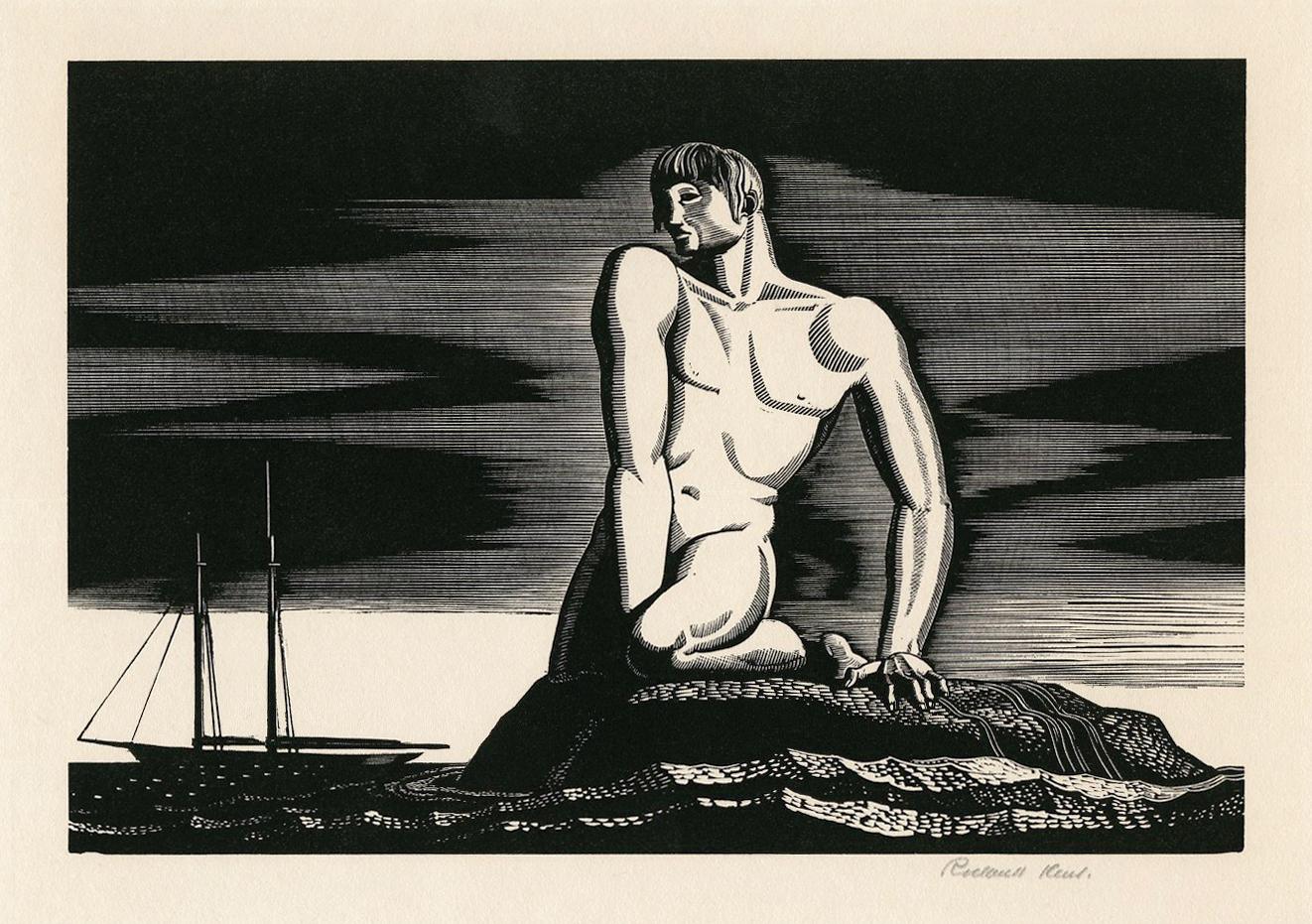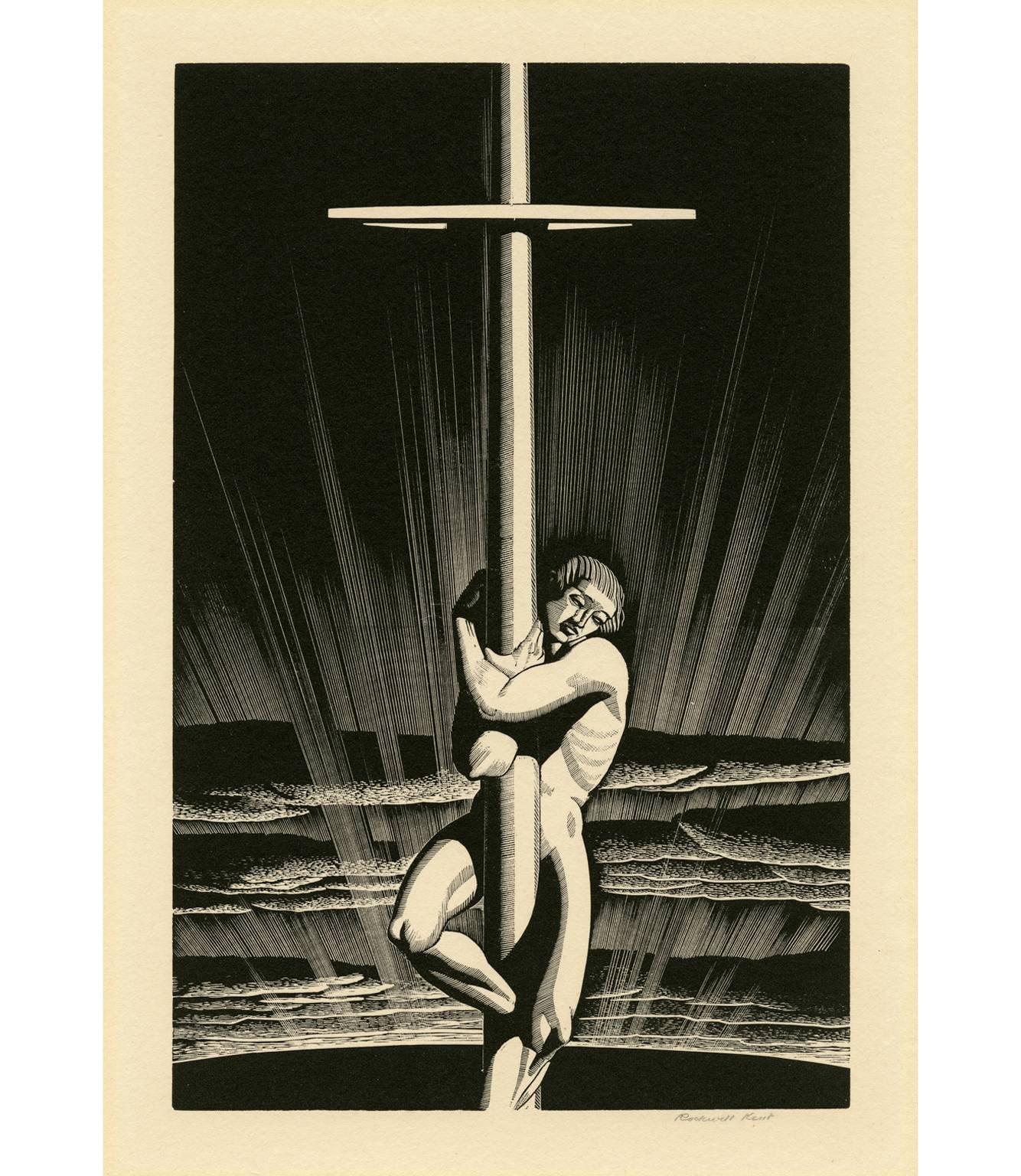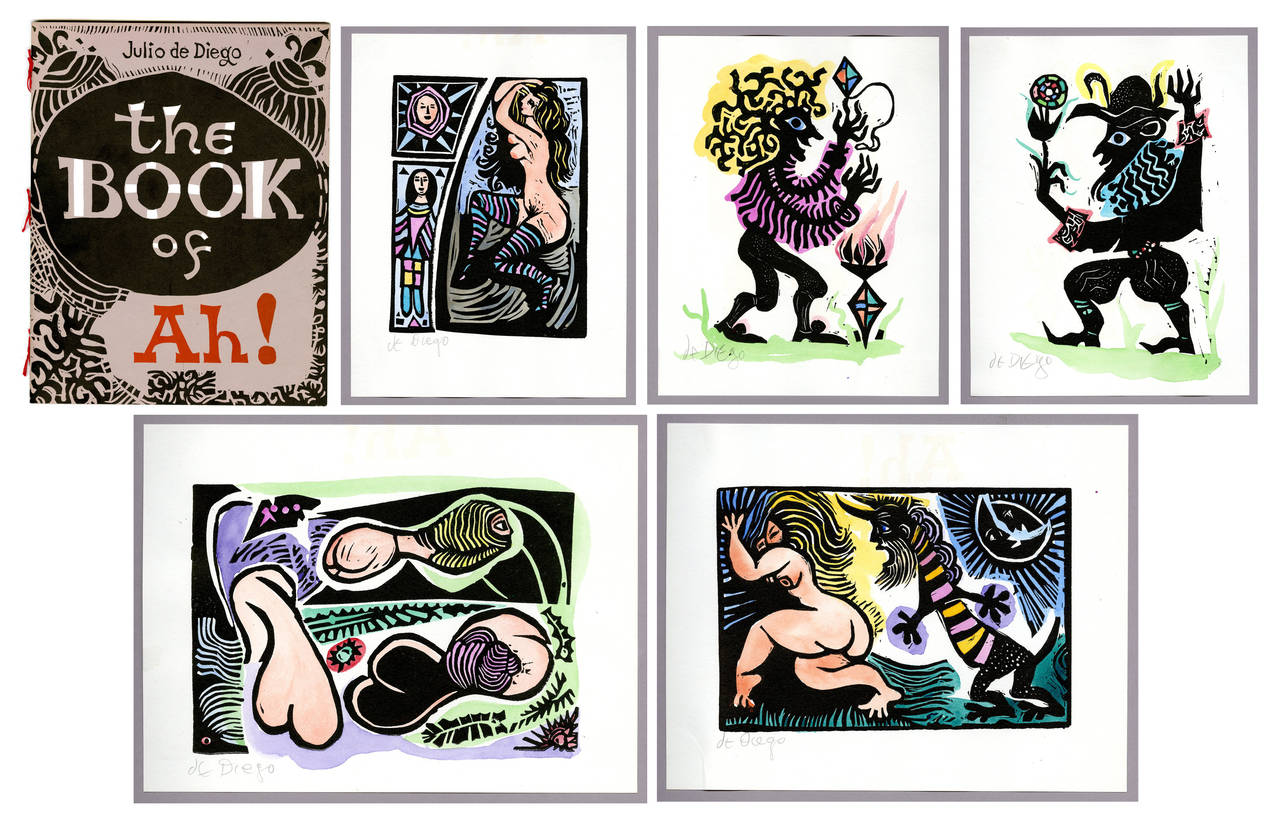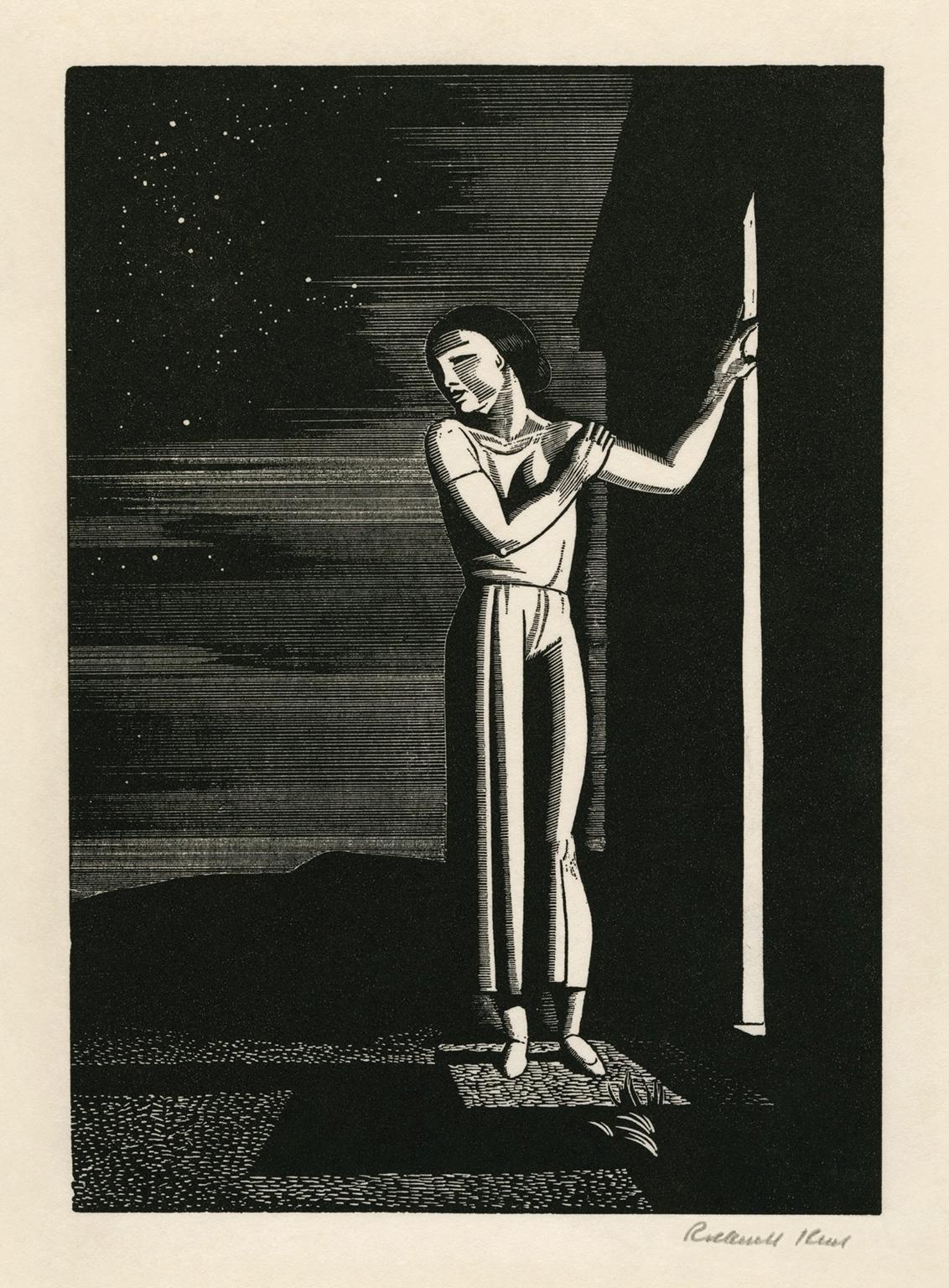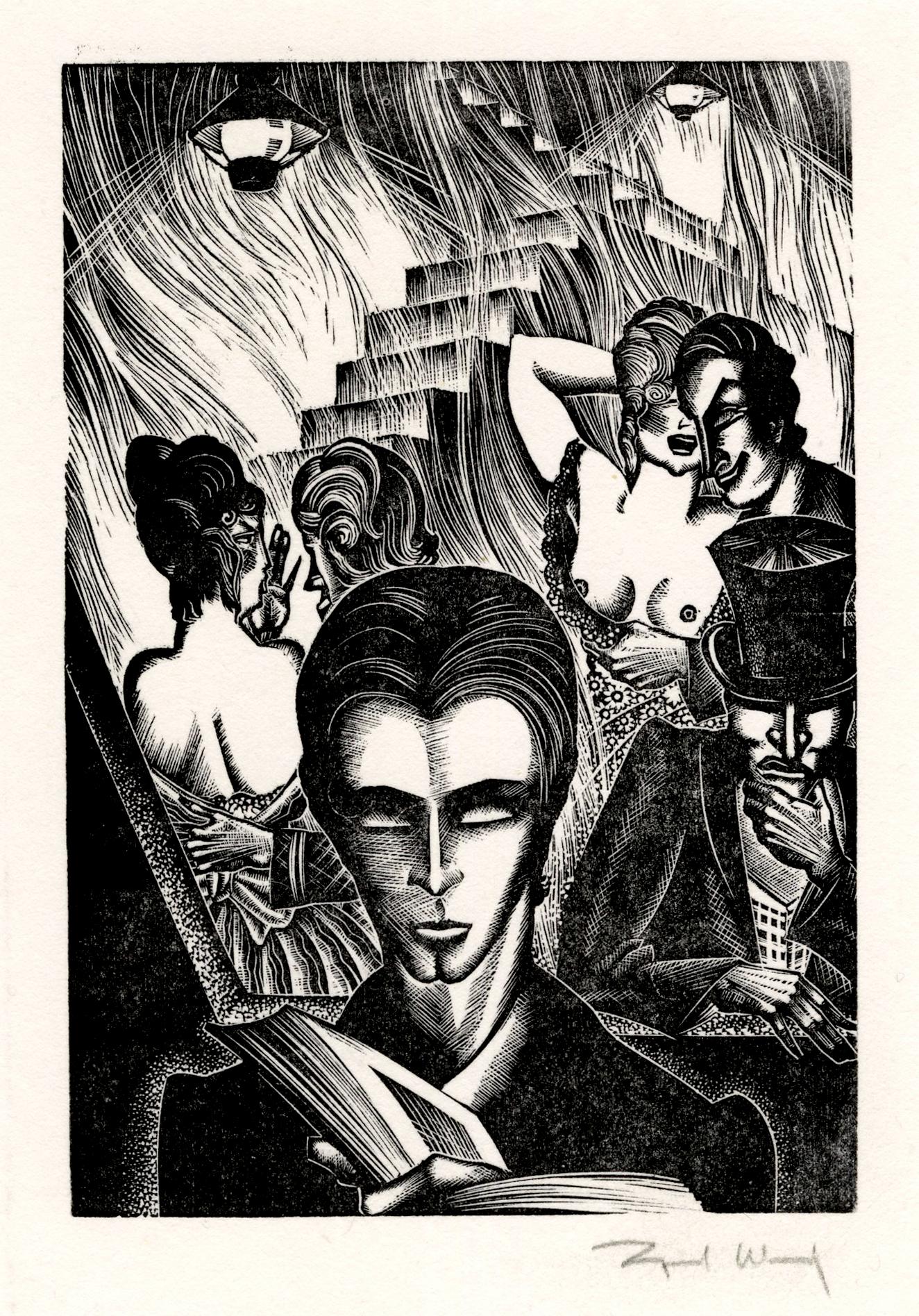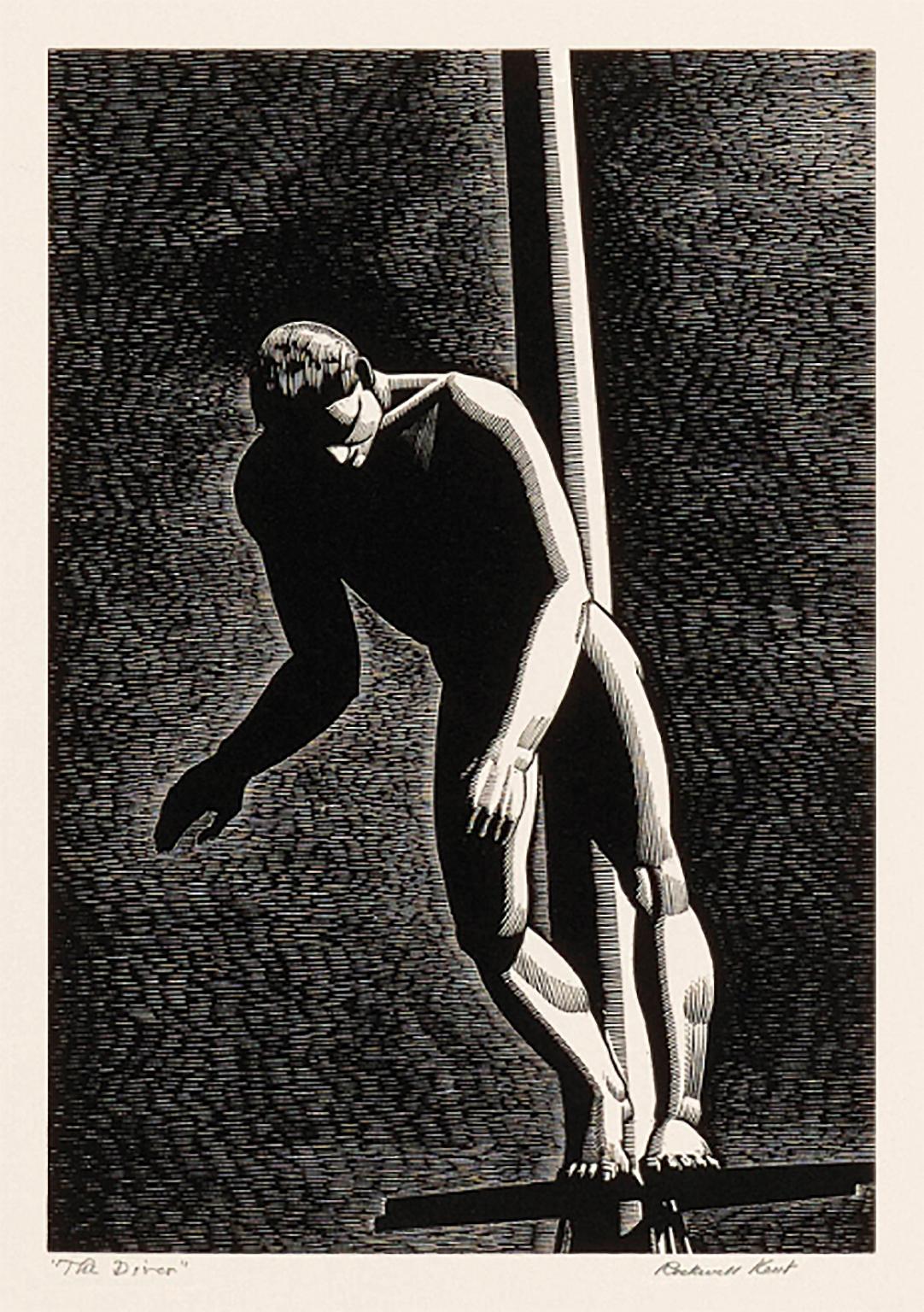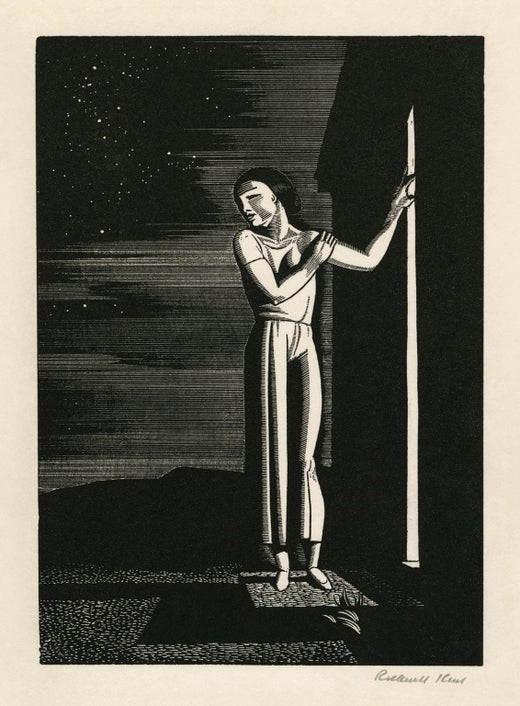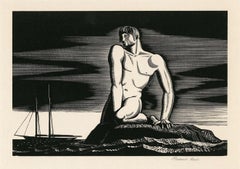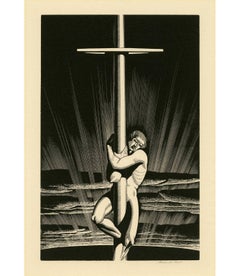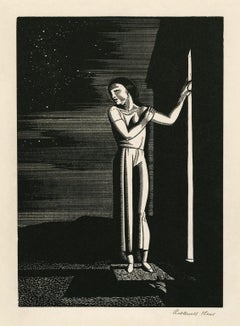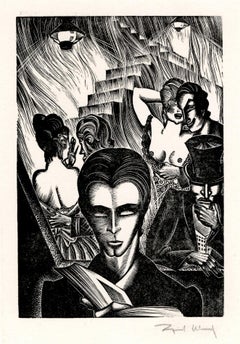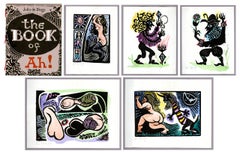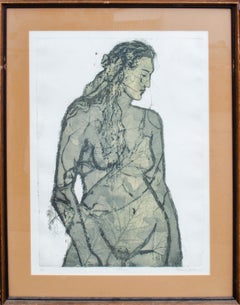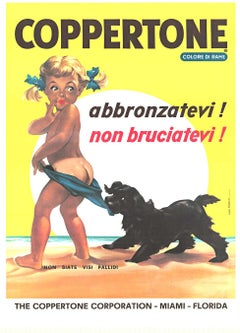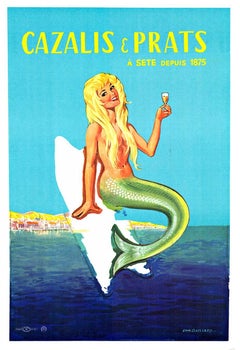Items Similar to 'Mountain Climber' — American Modernism
Want more images or videos?
Request additional images or videos from the seller
1 of 3
Rockwell Kent'Mountain Climber' — American Modernism1933
1933
About the Item
Rockwell Kent, 'Mountain Climber', wood engraving, 1933, edition 250, Burne Jones 93. Signed in pencil. A brilliant, black impression, on cream, wove Japan paper; the full sheet with margins (2 9/16 to 3 5/8 inches); slight skinning at the top sheet edge verso, where previously hinged; otherwise, in excellent condition. Archivally matted to museum standards, unframed.
Image size 7 7/8 x 5 7/8 inches (200 x 149 mm); sheet size 14 x 11 1/8 inches (356 x 283 mm).
Printed by Pynson Printers, New York. Distributed by The Print Club of Cleveland, Publication No. 11, 1933.
Literature: 'Rockwellkentiana,' Harcourt, Brace and Company, New York, 1933. '101 of The World’s Greatest Books', edited by Spencer Armstrong, 1950.
Impressions of this work are held in the following museum collections: Akron Art Institute, Burne Jones Collection, IL; Cincinnati Art Museum; Cleveland Museum of Art; Columbus Gallery of Fine Arts; Crystal Bridges Museum of American Art; Davis Museum at Wellesley College; Fine Art Museums of San Francisco; H. M. de Young Museum; Hermitage Museum; Kent Collection, NY; Library of Congress; Memorial Art Gallery, University of Rochester; Metropolitan Museum of Art; New York Public Library; Philadelphia Museum of Art; Princeton University Library; Smithsonian American Art Museum, Spector Collection, NY; SUNY, Plattsburg.
ABOUT THE ARTIST
Rockwell Kent (1882-1971), though best known as a painter, graphic artist, and illustrator, pursued many careers throughout his life, including architect, carpenter, explorer, writer, dairy farmer, and political activist. Born in Tarrytown, New York, Kent was interested in art from a young age. These ambitions were encouraged by his aunt Jo Holgate, an accomplished ceramicist. Jo came to live with the family after Kent’s father passed away in 1887 and took him to Europe as a teenager, undoubtedly kindling his interest in exploring the world.
Kent attended the Horace Mann School in New York City, where he excelled at mechanical drawing. His family’s financial circumstances prevented him from pursuing a career in the fine arts; however, after graduating from Horace Mann in 1900, Kent decided to study architecture at Columbia University.
Before matriculating at Columbia, Kent spent the first of three consecutive summers studying painting at William Merritt Chase’s art school in Shinnecock Hills, Long Island. There he found a community of mentors and fellow students who encouraged him to pursue his interest in art. At the end of Kent’s third summer at Shinnecock, Chase offered him a full scholarship to the New York School of Art, where he was a teacher. Kent began taking night classes at the art school in addition to his architecture studies but soon left Columbia to study painting full-time. In addition to Chase, Kent took classes with Robert Henri and Kenneth Hayes Miller, where his classmates included the artists George Bellows and Edward Hopper.
Kent spent the summer of 1903 assisting the eccentric painter Abbott Handerson Thayer at his studio in Dublin, New Hampshire—a position he secured through the recommendation of his Aunt Jo. Thayer’s naturalist lifestyle and almost mystical appreciation for natural phenomena greatly influenced Kent; he returned to Dublin for many years to visit Thayer and his family. Thayer gave the young artist time to pursue his work, and that summer Kent painted several views of the New Hampshire landscape, including Mount Monadnock. In 1905 Kent moved from New York to Monhegan Island in Maine, home to a summer art colony, where he continued to find inspiration in nature. Kent soon found success exhibiting and selling his paintings in New York, and in 1907, he was given his first solo show at Claussen Galleries. The following year he married his first wife, Kathleen Whiting (Thayer’s niece), with whom he had five children. The couple divorced in 1924, and Kent married Frances Lee the following year. They divorced after 15 years of marriage, and the artist married Sally Johnstone.
For the next several decades, Kent lived a peripatetic lifestyle, settling in several locations in Connecticut, Maine, and New York. During this time he took several extended voyages to remote, often ice-filled, corners of the globe, including Newfoundland, Alaska, Tierra del Fuego, and Greenland, to which he made three separate trips. For Kent, exploration and artistic production were twinned endeavors, and his travels to these rugged, elemental locations inspired his visual art and his writings. He developed a stark, realist landscape style in his paintings and drawings that revealed both nature’s harshness and its sublimity. Kent’s human figures, which appear sparingly in his work, often allude to the mythic themes of isolation, individualism, heroism, and the quest for self-connection. Important exhibitions of works from these travels include the Knoedler Gallery’s shows in 1919 and 1920, featuring Kent’s Alaska drawings and paintings, and the Art Institute of Chicago’s 1933 Paintings and Drawings of Greenland by Rockwell Kent. He wrote several illustrated memoirs about his adventures abroad, including Wilderness: A Journal of Quiet Adventure in Alaska (1920) and N by E (1930). His autobiography, It’s Me, O Lord, was published in 1955.
Around 1920 Kent took up wood engraving and quickly established himself as one of the preeminent graphic artists of his time. His striking illustrations for two editions of Herman Melville’s Moby Dick—simultaneously precise and abstract images that drew on his architect’s eye for spatial relations and his years of maritime adventures—proved extremely popular and remain some of his best-known works. Throughout the 1920s and 1930s, Kent produced a range of print media, including advertisements, bookplates, and Christmas cards. Kent’s satirical drawings, created under the pseudonym “Hogarth Jr.,” were published in popular periodicals, including Vanity Fair, Harper’s Weekly, and Life. In 1937 the artist was commissioned by the Federal Public Works Administration to paint two murals for the New Post Office in Washington, DC.
By the onset of World War II, Kent had largely disengaged from the New York art world. Instead, he focused his energies on a number of progressive political causes, including labor rights and preventing the spread of fascism in Europe. Though he never joined the communist party, his support of leftist causes made him a target of suspicion by the State Department, which revoked his passport after his first visit to Moscow in 1950 (though Kent successfully sued to have it reinstated). As his artistic reputation declined at home and his work fell out of favor, Kent found a new popularity in the Soviet Union, where his works were exhibited frequently in the 1950s. In 1960 he donated 80 paintings and 800 prints and drawings to the people of the Soviet Union, and in 1967 he was awarded the Lenin Peace Prize. Kent died of a heart attack in 1971 and was buried on the grounds of Asgard, his farm in New York’s Adirondack Mountains.
—edited from National Gallery of Art, Zoë Samels
Rockwell Kent’s work is held in every major American museum and many international collections, including the Addison Gallery of American Art, Art Gallery of Ontario, Art Institute of Chicago, Baltimore Museum of Art, Brooklyn Museum, Carnegie Museum of Art, Cleveland Museum of Art, Corcoran Gallery of Art,, Dallas Museum of Art, Farnsworth Art Museum, Fine Arts Museums of San Francisco, Harvard University Art Museums, Hermitage Museum (Russia), Hirshhorn Museum and Sculpture Garden, Hood Museum of Art at Dartmouth College, Indianapolis Museum of Art, Los Angeles County Museum of Art, Mead Art Museum at Amherst College, Metropolitan Museum of Art, Minneapolis Institute of Arts, Museum of Fine Arts Boston, National Gallery of Art, Pennsylvania Academy of the Fine Arts, Philadelphia Museum of Art, Phillips Collection, Portland Museum of Art, Princeton University Art Museum, Pushkin Museum of Fine Arts, Moscow (Russia), Smithsonian American Art Museum, Terra Foundation for American Art, Wadsworth Atheneum, Whitney Museum of American Art, Wichita Art Museum, Worcester Art Museum.
- Creator:Rockwell Kent (1882-1971, American)
- Creation Year:1933
- Dimensions:Height: 7.88 in (20.02 cm)Width: 5.88 in (14.94 cm)
- Medium:
- Movement & Style:
- Period:
- Condition:
- Gallery Location:Myrtle Beach, SC
- Reference Number:Seller: 1042001stDibs: LU532312589512
Rockwell Kent
Rockwell Kent, (1882-1971) was born in Plattsburgh, New York). As a painterand printmaker his work was captured scenes of nature and adventure with a sense of drama that made him one of the most popular American artists of the first half of the 20th century. Kent studied architecture at Columbia University but turned to painting and was a pupil of William M. Chase, Robert Henri, and Abbott Thayer. Best known as an artist and illustrator he worked as an architectural draftsman, as a lobsterman and carpenter on the coast of Maine, and as a ship’s carpenter. He explored the waters about Tierra del Fuego in a small boat and lived in Newfoundland, Alaska, and Greenland, drawing heavily upon these experiences for his paintings and travel books. Kent’s human figures, which appear sparingly in his work, often signify mythic themes, such as heroism, loneliness, and individualism.
About the Seller
5.0
Recognized Seller
These prestigious sellers are industry leaders and represent the highest echelon for item quality and design.
Platinum Seller
Premium sellers with a 4.7+ rating and 24-hour response times
Established in 1995
1stDibs seller since 2016
300 sales on 1stDibs
Typical response time: 1 hour
Associations
International Fine Print Dealers Association
- ShippingRetrieving quote...Shipping from: Myrtle Beach, SC
- Return Policy
Authenticity Guarantee
In the unlikely event there’s an issue with an item’s authenticity, contact us within 1 year for a full refund. DetailsMoney-Back Guarantee
If your item is not as described, is damaged in transit, or does not arrive, contact us within 7 days for a full refund. Details24-Hour Cancellation
You have a 24-hour grace period in which to reconsider your purchase, with no questions asked.Vetted Professional Sellers
Our world-class sellers must adhere to strict standards for service and quality, maintaining the integrity of our listings.Price-Match Guarantee
If you find that a seller listed the same item for a lower price elsewhere, we’ll match it.Trusted Global Delivery
Our best-in-class carrier network provides specialized shipping options worldwide, including custom delivery.More From This Seller
View All'The Bather' — American Modernism
By Rockwell Kent
Located in Myrtle Beach, SC
Rockwell Kent, 'The Bather', wood engraving, 1931, edition 120, Burne Jones 63. Signed in pencil. A brilliant, black impression, on cream, wove Japan paper; the full sheet with margins (2 1/2 to 3 1/4 inches); slight skinning at the top sheet edge, verso, otherwise in excellent condition. Archivally matted to museum standards, unframed.
Image size 5 3/8 x 7 7/8 inches (137 x 200 mm); sheet size 11 1/8 x 14 1/2 inches (283 x 368 mm).
Impressions of this work are held in the following public collections: Burne Jones Collection (Illinois), Chazen Museum of Art, Chegodaev Collection (Moscow), Kent Collection (New York), National Gallery of Art, Philadelphia Museum of Art; SUNY Plattsburg Art Museum, Princeton University Library, Pushkin Museum (Moscow), Smithsonian American Art Museum, Spector Collection (New York), University of Illinois.
ABOUT THE ARTIST
Rockwell Kent (1882-1971), though best known as a painter, graphic artist, and illustrator, pursued many careers throughout his life, including architect, carpenter, explorer, writer, dairy farmer, and political activist. Born in Tarrytown, New York, Kent was interested in art from a young age. These ambitions were encouraged by his aunt Jo Holgate, an accomplished ceramicist. Jo came to live with the family after Kent’s father passed away in 1887 and took him to Europe as a teenager, undoubtedly kindling his interest in exploring the world.
Kent attended the Horace Mann School in New York City, where he excelled at mechanical drawing. His family’s financial circumstances prevented him from pursuing a career in the fine arts; however, after graduating from Horace Mann in 1900, Kent decided to study architecture at Columbia University.
Before matriculating at Columbia, Kent spent the first of three consecutive summers studying painting at William Merritt Chase’s art school in Shinnecock Hills, Long Island. There he found a community of mentors and fellow students who encouraged him to pursue his interest in art. At the end of Kent’s third summer at Shinnecock, Chase offered him a full scholarship to the New York School of Art, where he was a teacher. Kent began taking night classes at the art school in addition to his architecture studies but soon left Columbia to study painting full-time. In addition to Chase, Kent took classes with Robert Henri and Kenneth Hayes Miller, where his classmates included the artists George Bellows and Edward Hopper.
Kent spent the summer of 1903 assisting the eccentric painter Abbott Handerson Thayer at his studio in Dublin, New Hampshire—a position he secured through the recommendation of his Aunt Jo. Thayer’s naturalist lifestyle and almost mystical appreciation for natural phenomena greatly influenced Kent; he returned to Dublin for many years to visit Thayer and his family. Thayer gave the young artist time to pursue his work, and that summer Kent painted several views of the New Hampshire landscape, including Mount Monadnock...
Category
1930s American Modern Nude Prints
Materials
Woodcut
'Sea And Sky' — 1930s Modernism
By Rockwell Kent
Located in Myrtle Beach, SC
Rockwell Kent, 'Sea and Sky', wood engraving, edition 150, 1931 (published 1932). A brilliant, richly-inked impression on cream wove Japan; the full sheet with margins (2 to 2 1/2 in...
Category
1930s American Modern Nude Prints
Materials
Woodcut
'Starry Night' — 1930s American Modernism
By Rockwell Kent
Located in Myrtle Beach, SC
Rockwell Kent, 'Starry Night' wood engraving, 1933, edition 1750, Burne Jones 103. Signed in pencil. A brilliant, black impression, on cream wove Japan paper; with margins (7/8 to 1 ...
Category
1930s American Modern Nude Prints
Materials
Woodcut
Madman's Drum (Brothel) — 'Story Without Words' Graphic Modernism
By Lynd Ward
Located in Myrtle Beach, SC
Lynd Ward, 'Madman's Drum, Plate 41', wood engraving, 1930, edition small. Signed in pencil. A fine, richly-inked impression, on off-white tissue-thin Japan paper; the full sheet with margins (1 5/8 to 2 1/2 inches); a small paper blemish in the upper right margin, away from the image, otherwise in excellent condition. A scarce, artist-printed, hand-signed proof impression before the published edition. Matted to museum standards, unframed.
Image size 5 1/2 x 3 3/4 inches (140 x 95 mm); sheet size 9 5/8 x 7 1/8 inches (244 x 181 mm).
From Lynd Ward’s book of illustrations without words, 'Madman’s Drum', Jonathan Cape and Harrison Smith, New York, 1930.
Reproduced in 'Storyteller Without Words, the Wood Engravings of Lynd Ward', Harry N. Abrams, New York, 1974.
ABOUT THE ARTIST
Lynd Ward is acknowledged as one of America’s foremost wood engravers and book illustrators of the first half of the twentieth century. His innovative use of narrative printmaking as a stand-alone storytelling vehicle was uniquely successful in reaching a broad audience. The powerful psychological intensity of his work, celebrated for its dynamic design, technical precision, and compelling dramatic content, finds resonance in the literature of Poe, Melville, and Hawthorne. Like these classic American writers, Ward was concerned with the themes of man’s inner struggles and the role of the subconscious in determining his destiny. An artist of social conscience during the Great Depression and World War II, he infused his graphic images with his unique brand of social realism, deftly portraying the problems that challenged the ideals of American society.
The son of a Methodist preacher, Lynd Ward, moved from Chicago to Massachusetts at an early age. He graduated from the Teachers College of Columbia University, New York, in 1926, where he studied illustration and graphic arts. He married May Yonge McNeer in 1936 and left for Europe for their honeymoon in Eastern Europe. After four months, they settled in Leipzig, where Ward studied at the National Academy of Graphic Arts and Bookmaking. Inspired by Belgian expressionist artist Frans Masereel's graphic novel ‘The Sun,’ and another graphic novel by the German artist Otto Nückel, ‘Destiny,’ he determined to create his own "wordless" novel. Upon his return to America, Ward completed his first book, ‘God's Man: A Novel in Woodcuts,’ published in 1929. ‘Gods’ Man’ was a great success for its author and publisher and was reprinted four times in 1930, including a British edition. This book and several which followed it, ‘Madman’s Drum,’ 1930, ‘Wild Pilgrimage...
Category
1930s American Modern Figurative Prints
Materials
Woodcut
'Diver' — 1930s American Modernism
By Rockwell Kent
Located in Myrtle Beach, SC
Rockwell Kent, 'Diver', wood engraving, 1931, edition 150, Burne Jones 88. Signed, and titled 'The Diver' in pencil.. A brilliant, black impression, on cream, wove Japan paper; the f...
Category
1930s American Modern Nude Prints
Materials
Woodcut
Modernist Nude — Atelier 17
Located in Myrtle Beach, SC
Russell T. Limbach, 'Untitled (Modernist Nude)', etching and aquatint, no known edition, c. 1930. Signed in pencil. A fine impression, on cream wove paper, with full margins (1 7/8 to 2 3/4 inches), in excellent condition. Image size 8 15/16 x 5 15/16 inches; sheet size 13 3/8 x 10 1/4 inches. Extremely rare. Matted to museum standards, unframed.
Probably created when Limbach was in Paris (1928-1934), where he was exposed to modernist printmaking explorations at Stanley William Hayter’s 'Atelier 17'.
ABOUT THE ARTIST
Born in Massillon, Ohio, Russell Limbach...
Category
1930s American Modern Nude Prints
Materials
Etching
You May Also Like
The Book of Ah!
By Julio de Diego
Located in Fairlawn, OH
String bound booklet (portfolio) with six hand colored woodcuts, signed in pencil by the artist, tipped in the book
Provenance:
Estate of the artist
By descent to his daughter Kir...
Category
1960s American Modern Nude Prints
Materials
Woodcut
Titania Lithograph, Midsummer Night's Dream, by Marion Epstein
Located in New York, NY
Marion Epstein (American, 1921-2002)
Titania, 1973
Lithograph
Framed: 31 1/2 x 25 x 1/2 in.
Numbered, titled, signed and dated bottom
For over 60 years, local artist Marion Epstein has worked through her art to bridge the personal and the political, family and career. A versatile and prolific artist, she has done sculpture, enameling, painting and photography. But it was printmaking that truly captivated her imagination.
Like many artists of her generation, Epstein was powerfully influenced by the political activism of the 1960s. A member of the Women's International League for Peace and Freedom, Epstein recalls attending meetings out of town with her young son in tow.
The anti-war movement influenced a number of her pieces. "Where Have All the Flowers Gone?" echoes the sentiment of the popular anti-war folk song. This very tall print (6-by-2-1/2 feet) in tones of black, cream and ochre shows a tall woman (Marion) shielding a child, with spindly flowers drooping around them.
"I didn't do abstractions," says Epstein. "I was always trying to say something."
Another anti-war piece, "Generations of Thy Children," combines oil painting and collage on a bisected canvas. On the right half, a lone figure of a Vietnamese child stands forlornly on a reddish orange background. The left side of the canvas is crowded with images of soldiers, artillery and politicians.
Epstein's print "Metamorphosis," completed following her participation in a civil rights march in Washington, tries to capture the changes and uncertainty in America during that time. In the background a white man looms with a questioning, almost fearful look on his face while the black youth in the foreground has his eyes downcast. Works such as "Dream Deferred" and "Aching To be Free" also represent the artist's personal reflections on the struggle for racial equality.
Much of Epstein's art is a complex layering of imagery and texture, line and translucent color. In her haunting print, "Ovens and Shoes," one of several works in which she addresses the Holocaust, she makes interesting use of photographic images from the U.S. Holocaust Memorial Museum in Washington, D.C. Over a saturated black print of the death camp ovens, she has superimposed a pale ochre print of the pile of discarded shoes. Layered on top of these and centered between the arches of the ovens is the violet image of a Rodin sculpture of a man.
(Bio sourced from Cleveland Jewish News, by Susan Kahn)
Category
1970s American Modern Nude Prints
Materials
Lithograph
Original Coppertone Italian sun tan cream, small format vintage poster
Located in Spokane, WA
The Original Coppertone Italian suntan lotion vintage poster is in small format. It is backed with archival linen and is in Grade A condition. It is ready to frame.
Step Back in Time, One Tan at a Time!
Elevate your space with a piece of pop culture history! This original Coppertone vintage...
Category
1950s American Modern Nude Prints
Materials
Offset
Original CAZALIS & PRATS Grand Cru Mermaid vintage French liquor poster
Located in Spokane, WA
Original CAZALIS & PRATS since 1875. Artist: Emm. Gaillard. Size: 13" x 19.5". Professionally acid-free archival linen backed and ready to frame. Note that a small ink printing line ...
Category
1950s American Modern Nude Prints
Materials
Lithograph
Good Times I -- Couple Nude Figurative
By Weyman Lew
Located in Soquel, CA
Weyman Michael Lew is a painter and printmaker, born in San Francisco, California in 1935. Without over-mat, silver tone aluminum frame and plexi-glass. Imaqe, 22"H x 27"L.
He studied at the University of California, and the San Francisco Art Institute from 1965 to 1966 with Artist Mary Joan Jay DeFeo. His works are in the collection of De Young Memorial Museum; the Institution of Arte Contemporary in Lima, Peru; the Western American Artists...
Category
1970s American Modern Nude Prints
Materials
Acrylic, Etching
Balinese Mother and Child
By Beniamino Bufano
Located in San Francisco, CA
This artwork titled " Balinese Mother and Child" 1970 is an original color lithograph on Japan nacre paper by noted Italian/American artist Beniamino Benevenuto Bufano, 1890-1970. It is hand signed, inscribed Bon a Tirer and dated 1970 in pencil by the artist. The image size 14 x 9,75 is inches, framed size is 27.35 x 21.75 inches. Published by First Impressions, San Francisco, printed by Fikrat Al-Khouri at First Impressions Graphic Society. it is beautifully custom framed in a wooden gold frame, with gold color spacer. It is in excellent condition.
About the artist:
Beniamino Benvenuto Bufano was born in San-Fele, Italy on Oct. 14, 1889. At age three Bufano's family brought him to NYC where he spent his childhood and was educated by private tutors. He studied at the ASL in NYC from 1913-15, the pupil of James L. Fraser, Herbert Adams, and Paul Manship. He came to San Francisco in 1915 to work on a sculpture for the PPIE. For awhile he worked in the studio of coppersmith Dirk van Erp. He then traveled extensively for four years in France, Italy, India, and China. After returning to San Francisco in 1921, he remained there the rest of his life except for visits to the Orient and Europe. Always a radical, he lost his teaching position at San Francisco Institute of Art in 1923 because he was too modern for the conservative faculty. He later taught at UC Berkeley and the CCAC (1964-65). Henry Miller wrote of him, "He will outlive our civilization and probably be better known, better understood, both as a man and artist, five thousand years hence." His work, simple in style and monumental in scale, includes smoothly rounded animals in granite and icons sheathed in stainless steel. Only five feet tall, Bufano was a controversial, free spirit until his death in San Francisco on Aug. 16, 1970. Member: SFAA; NSS; American Artists Congress. Exh: Whitney Museum (NYC), 1917; Arden Gallery...
Category
Late 20th Century American Modern Nude Prints
Materials
Lithograph
Recently Viewed
View AllMore Ways To Browse
American Brilliant
Japanese Mountain
1930s Modernism
William Kent
Crystal Mountain Sculpture
Vintage Adirondack Signs
Japanese Carpenter
1920s Christmas
Whiting And Davis
Crystal Ice Cream
Herman Miller Vanity
Herman Miller Summer
Armstrong Jones
Armstrong Jones
American Brilliant
Vintage Adirondack Signs
1920s Christmas
William Kent
